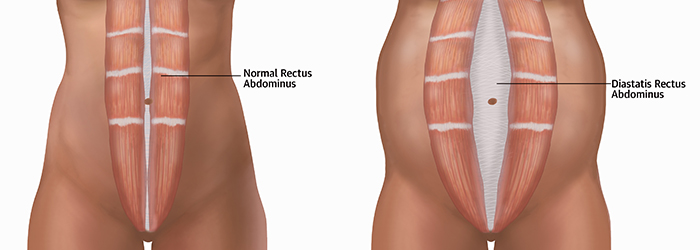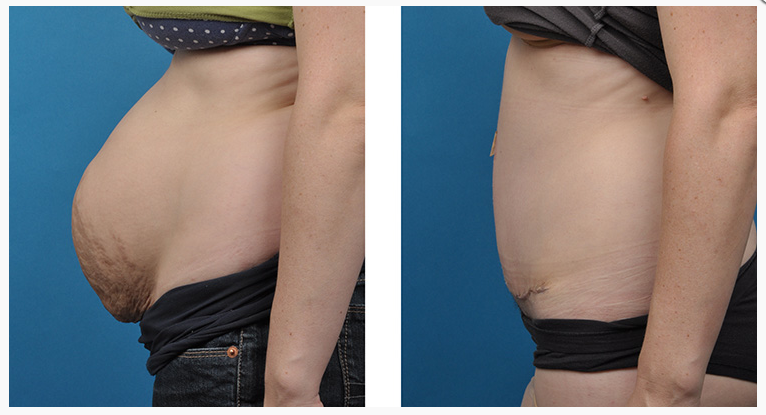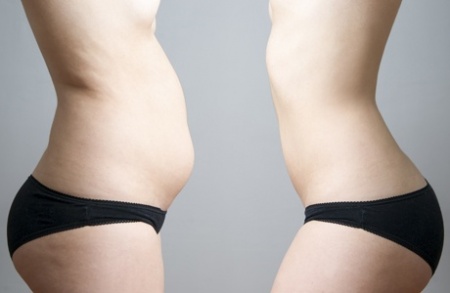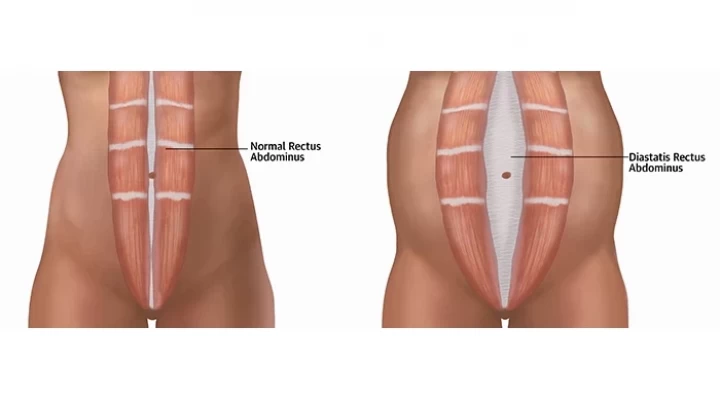Abdominal separation, also known as diastasis recti, is a common condition that occurs when the muscles of the stomach are pulled apart. It often develops during pregnancy, and can lead to serious health and aesthetic issues. Our plastic surgeon Dr Bernadett Lévay and physiotherapist Rita Haness explain what can be done about it.

A part of pregnancy
Abdominal separation during pregnancy is a completely natural process. As the baby grows in the womb, the stomach wall expands greatly, leading to a separation of the connective tissue (linea alba) between the two strips of muscle (rectus abdominis) running down the middle of the abdomen to make space for the enlarged womb. This process is not usually problematic, and the area returns to normal in the weeks following the birth as the body regenerates.
When is it a problem?
Unfortunately, the situation is not always so simple. As the muscles separate, the ligaments can stretch, damaging and in some cases rupturing the connective tissue. If the gap between the muscles is wider than two inches, or if the irregularity persists for a several months after birth, this may indicate a serious problem and you should consult a professional. More significant abdominal separation can occur as a result of being overweight, bearing twins, lifting heavy objects or having weaker muscles and connective tissues.

Not just an aesthetic issue
The most typical sign of abdominal separation is the formation of a bump between the navel and sternum. This can look like you simply have a large stomach, similar to being a few months pregnant, and can potentially cause self-esteem and confidence issues. Even more serious are the potential long-term physical effects: backache, hernias, incontinence and spinal and lower back problems.
How far have my stomach muscles separated?
The abnormality may not be visible, so you can follow the steps outlined below to check if you have abdominal separation:
- lie on your back
- pull your knees up
- take a deep breath
- raise your head and shoulders, as if you were doing ab crunches
- press your thumb on your navel and up towards your stomach
- apply pressure up in an area of around 4-5 cm
You should be able to judge by how much weight you can press into your stomach, which indicates whether your stomach muscles are properly closed or not.

Solutions
- Prevention
This problem can be prevented by doing stomach exercises before and during pregnancy, having good posture and taking care not to lift heavy objects, e.g. doing weight-based workouts. If you already have children in the family and are pregnant, don’t lift the children. Stomach muscle exercises for expectant mothers are not the usual leg lifts and sit-ups, but specific movements with coordinated breathing suggested by a physiotherapist.
- Exercise
In most cases, abdominal separation can be treated with functional abdominal training, though this is a lengthy process and requires a lot of work. The purpose of the training is to tone and strengthen the stomach muscles so that the frontal abdominal muscles can then be drawn together. You should consult a physiotherapist before you start, as certain exercises do more harm than good.
As well as doing exercises, it can be a good idea to use kinesio tape, which helps to bring together and regenerate the ruptured fibers.
- Operation
If the situation is very serious, an operation may be required. During the procedure, the abdominal muscles are stitched together, eliminating the looseness of the abdominal wall. The operation takes place under anesthetic and lasts one to two hours, while the complete recovery time is two to three months. Surgery can only be carried out after pregnancy if the mother has lost any extra weight and has kept her weight stable for at least six months.
Image credits:
http://www.abdomupdates.com/2015_11_01_archive.html
http://crossfitsands.com/wp-content/uploads/2016/11/IMG_7790.jpg
http://www.babanet.hu/gyerek/anyasag/gyerunk-anyukam-te-szereted-magadat/
- pediatrics21
- dietetics20
- RMC Dental Center15
- diet13
- internal medicine11
- dentistry9
- pediatric dentistry8
- sport7
- Dr Kinga Jókay7
- coronavirus6
- screening6
- covid6
- urology6
- obstetrics gynecology6
- prevention5
- cardiology5
- allergy5
- psychology5
- dental hygiene5
- infection4
- gastroenterology4
- menopause4
- screenings3
- Kinga Jókay M.D3
- Flu shot3
- Flu3
- women's screening3
- zsuzsanna kókai2
- Dr Nóra Gullai2
- infectious disase medicine2
- Ear-Nose-Throat2
- heat stroke2
- endocrinology2
- Dr Tímea Baló2
- allergen immunotherapy2
- Adrienne Nagy M.D.2
- Fetal Medicine Center2
- pediatric urology2
- flu season2
- meningitis2
- dermatology2
- gynecologist2
- Ophthalmologist2
- Headache Clinic2
- Dr Eszter Bodnár2
- headache2
- menopause program2
- invisalign2
- diabetology2
- cardiovascular disease1
- diabetes1
- hydration1
- hematology1
- iron1
- Imre Bodó M.D.1
- Same Day Surgery Center1
- nutritional disorder1
- lyme disease1
- gynecologic oncology surgery1
- first trimester screening1
Any questions before booking an appointment?
If you are unsure which doctor to see or what examination you require, we are here to help!
Simply request a free callback from one of our colleagues, who will help you find the right specialist based on your specific issue.





